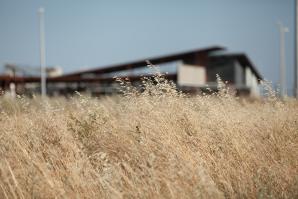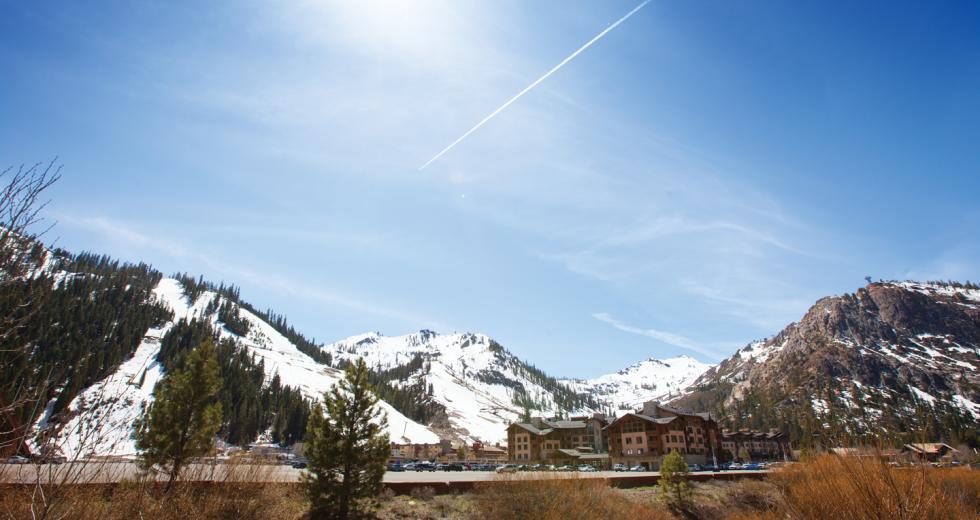Squaw Valley USA was once the premier ski resort of California and the world-renowned site of the 1960 Winter Olympic Games. But in the decades that followed, the resort’s managers focused on the mountain, and Squaw became eclipsed by other resorts that boasted hotel rooms and other amenities to capture business in the dry months.
Squaw currently ranks 16th in the top 20 ski resorts in North America, but CEO Andy Wirth says new development within the resort’s eponymous village has the potential to push it into the top five. With its owner KSL Capital Partners, a Denver-based investment firm, Squaw is ready to transform its resort with a four-season recreation center. Squaw is proposing more than 2,000 new rooms and an array of indoor and outdoor recreational entertainment, including swimming pools and mountain climbing for the summer months when business sharply falls.
But there are some water challenges that could hinder the project.
“The total volume that comes out of the watershed can serve way more people than it currently does,” says Mike Liquori, principal at Sound Watershed Consulting in Alameda, a group that has been studying other water storage options for Squaw Creek since 2005. “The primary challenge is where to store the water.”
Timing is also an issue, according to Chevis Hosea, development spokesman and vice president of Squaw Valley Real Estate. “The real key is how much water is used in July and October,” when Squaw Creek naturally has the lowest flow and the aquifer enters its driest phase. There’s enough water now, but a development boasting thousands of new units could bring hoards of visitors, raising concerns of a water shortage in the summer when activity is normally down.
Along with KSL, which has a record of working with North America’s most renowned ski resorts, including Colorado’s Vail Mountain Lodge & Spa and British Columbia’s Whistler Blackcomb, Squaw has already pledged to spend $1.5 million on water restoration.
On top of restoring the creek, the developer has also spent another $1 million on its own water supply assessment. Squaw is working with the Squaw Valley Public Service District, which is conducting the main water supply assessment in accordance with the California Environmental Quality Act. The results are expected in July, and, if satisfactory, the developer will take the proposal to the Placer County Board of Supervisors for a decision next year. If approved, the entire development will be complete within 12 to 15 years.
While the majestic mountains earned Squaw Valley the spotlight for the Winter Games more than 50 years ago, the creek has been seen as problematic. Squaw Creek, already in a state of change due to decades of overgrazing around the creek’s meadow, was altered again to complete the resort. The U.S. Army Corps of Engineers took the meandering mountain creek and made a trapezoidal channel to prevent flooding and drain water to make room for a parking lot.
Another problem is sediment buildup that has landed the creek on the Lahontan Regional Water Quality Control Board’s list of bodies of water not meeting Clean Water Act standards.
“I think there’s an opportunity for improvement,” says Ed Heneveld, 66, resident and chairman of the grassroots environmental organization Friends of Squaw Creek. “But it will never go back to the original function of a creek that’s supposed to function.”
A retired financier, Larry Tomlinson first moved to Olympic Valley in 1993 after his family lived in Switzerland and fell in love with skiing. Though he raised his kids there, he said it’s almost impossible for families to stay due to a lack of stable jobs that pay a living wage year-round, so he trusts Squaw to take care of the creek to improve the economic climate.
“Some of the locals use [the creek] as a lever to not expand, but the surveys have shown there’s enough water for the Village,” he said. “I think water management will become much better.”
The developer’s independent water supply assessment tested three
new wells. These results have been given to the district, and
Wirth says they are confident about the findings.
“Virtually every mountain resort has to go through this process,”
he said. “We are required to go through this. We want to adhere
to our commitment to honest science and objective science to move
onward.”
During summertime at Squaw, the economy takes a nosedive. In the winter, 2,000 employees could be working at Squaw, Hosea said, but that number is slashed by 90 percent once the weather warms. Olympic Valley’s unemployment rate is above 10 percent, excluding those who become underemployed seasonal workers. So the proposed development could bring more business.
“My hardest thing with a business is the seasonality,” says Elsa Corrigan, owner of Mamasake restaurant in the Village at Squaw. When the snow dries up and the tourists leave, Corrigan cuts her staff of 30 by one third.
“It’s so busy in some months. It’s one-sixth the business in other months,” she says.
By some estimates, the proposed development would bring in $30 million yearly in tax revenues and up to ten percent of the transient occupancy tax to Placer County, benefitting Olympic Valley, Truckee and Tahoe City. It could create 3,000 jobs, Hosea says, with 2,000 in construction alone.
Covering 101 acres, new features like upscale condo hotels and an adventure center could heighten year-round tourism.
“If you’re a family who wants the high-end experience and you’re in Chicago, Squaw Valley is generally not in that conversation. This additional room product will give us the opportunity to be in that conversation,” Hosea says. “That family’s mostly considering Vail, Aspen or Whistler Blackcomb.”
Also, these upgrades are expected to help Squaw compete locally with nearby resorts that boast summer activities such as golfing, hiking and mountain biking.
“[Martis Camp] built a wonderful community. Northstar, any time of the year, there’s something to do. They’re slowly taking that business away from Squaw,” says resident and businessman Richie Goldman of the neighboring resort, Northstar California. “At the end of the day, Squaw has more going for it than Martis and Northstar, and it should take advantage of it.”
Did You Know?
The city of Roseville and private developers have spent upward of $80 million upgrading more than 50 downtown businesses, the community theater, building facades and public landscapes. And there is more to come. Baltimore-based The Cordish Cos. and Sacramento-based The Evergreen Co. have been selected as master developers for Roseville’s upcoming downtown/Vernon Street overhaul, which will include the construction of new commercial, civic and residential buildings over 20 years. Locally, The Evergreen Co. developed the Folsom Corporate Center and Creekside Center in Roseville, and recently bought the Crestview Village Shopping Center in Carmichael.
Did You Know?
A new, high-end senior living and memory care facility will open this summer in Roseville. The 80-unit Oakmont of Roseville is a luxury assisted-living community that will include a doctor’s office, salon and day spa, movie theater, restaurant-style dining and pet park. Reservations are already open for the units, which range from 400-square-foot studios to 1,200-square-foot, two-bed, two-bath apartments. Rates start at $3,395 a month, which includes all meals, daily chauffeured transportation and weekly housekeeping.
Recommended For You

Job Creation
Elk Grove’s plan to build new businesses from the ground up
In March, the Elk Grove city council voted to develop the last large swath of land in its jurisdiction. But this time around, instead of focusing on rooftops, as the city has for the past decade, leaders and developers hope to bolster the local economy by building new businesses.

The Auburn Advantage
How one city turned lifestyle into business leads
Downtown Auburn has a distinct, modern-day Mayberry feel, from the stone-paved sidewalks to the rustic brick bus stop. But five miles away,



